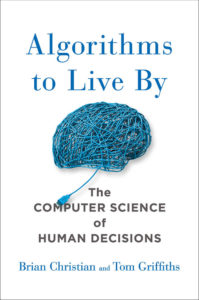 I’m currently working my way through the book Algorithms to Live By: The Computer Science of Human Decisions by Brian Christian & Tom Griffiths, which deconstructs many key life decisions into algorithms that can lead to optimal decision-making. As it cogently reviews many basic concepts using a wide range of life examples, I can see many ways in which machine learning techniques could sift through mountains of clinical data on cancer patients to help guide our management decisions in ways that elude the limitations of human brains. Here are a few of the most important clinical questions that we mortal oncologists struggle with but are very amenable to development of algorithms once machine learning tools are applied:
I’m currently working my way through the book Algorithms to Live By: The Computer Science of Human Decisions by Brian Christian & Tom Griffiths, which deconstructs many key life decisions into algorithms that can lead to optimal decision-making. As it cogently reviews many basic concepts using a wide range of life examples, I can see many ways in which machine learning techniques could sift through mountains of clinical data on cancer patients to help guide our management decisions in ways that elude the limitations of human brains. Here are a few of the most important clinical questions that we mortal oncologists struggle with but are very amenable to development of algorithms once machine learning tools are applied:
1) When should we change treatments? Oncologists work with patients to weigh decisions about whether a treatment with partial benefit (limited shrinkage of a cancer or even modest progression) is good enough to continue treatment and when a stronger choice is to change treatment approaches. When is is the expected benefit of more of the same, likely with a discount from diminishing returns, less than the anticipated or unknown benefits of the next alternative therapy? A well honed algorithm should be able to follow the growth kinetics of a cancer on scans and predict when it’s time to change horses.
2) When are the existing alternatives less appealing than the real unknown of an investigational approach? If we can estimate the benefit of treatments with established efficacy, when does a clinical trial emerge as a stronger option than our current standards?
3) How well can we refine a patient’s prognosis based on a cancer’s prior growth pattern? When patients ask how long they might live, we have only crude statistics that are based on the general population of their cancer’s type and stage, but experienced oncologists recognize that cancers that fall into the same group can vary from indolent to far more aggressive and that this factor is critical in predicting the future behavior of a cancer. A good machine learning process should be able to review the pace of the cancer over time and offer a far more refined prognosis to an individual patient, which can help us decide if or when it is necessary to intervene for a relatively slower growing cancer.
4) Similarly, all too often we struggle with the question of whether subtle changes on imaging represents a meaningful change, either better or worse. Paired with computer-aided image analysis of imaging, which is advancing rapidly and can precisely measure volume of irregularly-shaped masses, algorithms should be able to detect subtle patterns human eyes and brains miss with our very simple measurements will miss or only vaguely appreciate. A good set of computer-aided eyes paired with meticulous detection of changes over time on treatment will improve our ability to determine whether patients are responding or progressing on a current therapy.
5) Of course, machine learning to interpret the patterns in “big data” from genomic testing will be critical as we move to an era of broadly testing cancers for any of hundreds or even thousands of genetic mutations. For the vast majority, we know very little about how they correlate with response to everything from conventional chemotherapy to targeted therapies or immunotherapy. Machine learning will be able to discern patterns in data that no human brain can process, ideally allowing us to capitalize on all of the data we’ll be producing as we move to a new era of molecular oncology.
These are only a few obvious ways in which artificial intelligence can be applied to improve outcomes for cancer care. I look forward to a time when AI processes review our individual patient and population-based data and highlights ways to improve our management by seeing things that are invisible to even the best human oncologists.

Leave a Reply